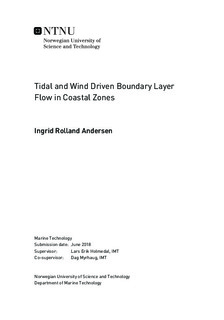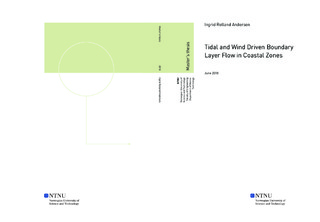| dc.description.abstract | The objective with this thesis is to investigate the start-up of a pure wind driven flow, and the effect of an suddenly increasing wind (starting from zero wind speed) on a tidally driven flow. This is done by performing simulations of a wind driven flow beneath a constant and an increasing wind, with no tidal forcing. Further, a pure tidally driven flow is simulated and a suddenly increasing wind is imposed when the tidal flow has obtained steady state conditions. These simulations are compared with a fully developed flow beneath a constant wind with and without tidal forcing, respectively. For all cases the difference between imposing a strong and weak wind on the flow is also accounted for. Studying the tidally driven flow beneath an suddenly increasing wind starting at zero wind stress have, to the authors knowledge, not been done before. To predict the pure wind driven and combined tidal and wind driven flows a one-dimensional boundary layer model is applied. The horizontal velocities are calculated at 814 gridpoints in the vertical direction along the water column, with the highest resolution close to the sea bed and close to the sea surface where the flow is complex. A two-equation turbulence closure model is utilized to account for the turbulent flow.
Findings from the simulations of a pure wind driven flow showed that the particle trajec-
tories beneath a weak wind is rotated further to the right relative to the direction of the
wind stress, compared to a strong wind. This is assumed to be caused by the strong wind
inducing more turbulence in the flow, which decreases the rotation of the surface Ekman
current. This is consistent for the flow beneath a constant and a suddenly increasing
wind. The particle trajectories in the flow beneath an increasing wind appears to move
in a circular motion in the start-up of the simulation when the wind speed is low. This
is especially seen for depths close to the sea bottom. The circular motion is similar to a
trajectory only affected by the Coriolis force, and this may be caused by the inertia of
momentum down in the water column. The Coriolis force is proportional to the horizontal
velocities u, v and the shear force to the velocity gradients du , dv , and the results implies dz dz
that the Coriolis force dominates over the shear force when the horizontal velocities are small and there is no tidal current.
The velocity profiles for the combined tidal and wind driven flow shows little difference in the speed compared to the velocity profiles for a pure tidally driven flow. This implies that the tidal current is dominating the velocity in the flow, and the effect from the wind on the horizontal velocities are mostly limited to the flow close to the ocean surface.
The direction of the mass transport (drift) through the water column in a combined tidal and wind driven flow varies for a flow beneath a constant and a suddenly increasing wind, despite the same resulting wind speed. This is likely to be caused by the difference in wind speed in the start-up of the simulation, were the constant wind induces a drift rotated further to the right relative to the direction of the wind speed, compared to the increasing wind. These results consist with the Coriolis force being proportional to the horizontal velocities u, v in the flow, where an increased magnitude of u, v results in a higher effect of the Coriolis force rotating the trajectories beneath a constant wind to the right compared to the direction of the wind. The flow beneath an suddenly increasing wind will have lower horizontal velocities and the trajectories are not affected of a Coriolis force of the same magnitude as the flow beneath a constant wind.
In conclusion, the effect of an increasing wind on the flow is different than the effect of a constant wind. The presence of a tidal flow results in turbulent mixing which reduces the difference due to little inertia of momentum down in the water column, but e.g the direction of drift beneath an increasing wind deviates compared to the drift in a flow beneath a constant wind. In exposed seas as e.g the North Sea transient winds may be more relevant compared to steady state conditions, and the knowledge about these types of winds should be investigated further. For further work it could be interesting to compare the difference of a tidally driven flow beneath a wind increasing exponentially or with another ramp than linear, which is applied here. The effects of surface waves due to the wind should also be investigated further in order to predict a sea state as realistic as possible. | |

